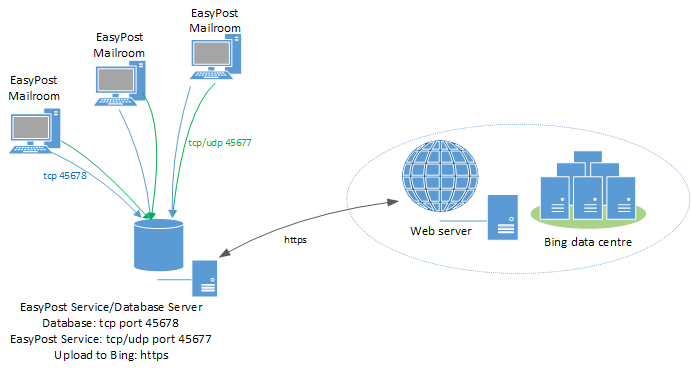The EasyPost Mailroom consists of several components:
- EasyPost Printer Driver - This allows you to print to the EasyPost Mailroom from any application.
- EasyPost Mailroom - Software that lets you prepare your mailings for submission to Bing.
- EasyPost Mailroom Database Service - Stores mailings and the documents printed to the Mailroom printer driver.
- EasyPost Service - Manages configuration, status updates and document uploads to Bing.
Components
The Mailroom Printer Driver is a Windows GDI printer driver that captures documents as they are printed and stores them in a proprietary format in the EasyPost Mailroom database.
The EasyPost Mailroom is the application where items that have been printed to the EasyPost Mailroom printer have addresses and other metadata extracted. Users can then review, combine different print jobs, group letters into envelopes by matched addresses, and then submit them to Bing for processing. Once submitted, those mail items are tracked, displaying the status in the Mail Items Summary window.
The Mailroom can be configured in interactive mode or fully automated (Silent Send) through the use of preset rules.
The EasyPost Mailroom Database Service stores mail items, attachments and letterheads in a proprietary format. The database is installed as a separate service and uses a client (Mailroom) server (Database) topology. A database is automatically created if it doesn’t exist. The EasyPost Service determines configuration i.e. which database host and database to connect to, allowing each EasyPost installation to be configured differently if required. An EasyPost Mailroom can access a shared Mailroom Database or a Mailroom Database specific to the user (non-shared).
The EasyPost Service performs 3 functions: Upload, Configuration and Communication.
The service replaces the EasyPost Spooler as the uploader of Mailings (Mail Items) to Bing. Mailings stored in databases, once submitted, are packaged and then sent to Bing over secure HTTPS. The upload function of the service employs auto-resume capabilities and positive upload confirmation to ensure that files are successfully uploaded.
EasyPost Service manages configuration. Users can be grouped into OUs (Organisational Units) within a hierarchical structure, can inherit default presets and other settings, or be denied access to features.
The EasyPost Service is the only component to communicate externally with Bing. Configuration settings and status updates are retrieved from Bing's web services with all communication performed over the secure HTTPS protocol.
Deployment
Stand Alone
A complete installation of the Mailroom installs all components and provides a stand alone Mailroom solution out of the box.

Fig 1.1
Client-Server
Services and components may also be split and installed separately. Some organisations may prefer to install the client features only to the SOE i.e. Printer driver, Status and Mailroom application. The Database and EasyPost services can be installed on a single dedicated server, as per figure 1.2, or on separate servers. Bing recommends running both the Database and EasyPost services on the same host for performance and ease of administration.
The EasyPost Mailroom clients require access to the database service on TCP port 45678 and the EasyPost service on 45677 with both TCP and UDP. UDP is used only in the EasyPost service discovery process.

Fig 1.2
Configuration Tree
The configuration tree is serviced by the EasyPost Service and can support complex enterprise setups. If required, multiple accounts can exist under a single organisation hierarchy, meaning users can register and print to different accounts and/or OUs within those accounts.
Settings can be changed at any level of the hierarchy, similar in concept to Active Directory. Simply change a setting or preset at the top of the tree to apply to all Mailroom users, or make a change at a lower level e.g. a department OU to apply settings to only that subset of users.
The configuration tree is designed to make the management of any EasyPost Mailroom deployment as simple as possible.
